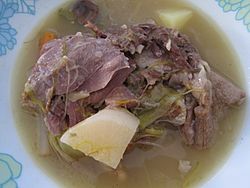Garbure facts for kids
 |
|
| Type | Soup or stew |
|---|---|
| Place of origin | France |
| Main ingredients | Ham, cabbage and other vegetables, cheese, stale bread |
Garbure is a thick and hearty French stew. It traditionally features cabbage and confit d'oie, which is duck or goose meat preserved in its own fat. Today, you'll often find it made with ham, cheese, and even stale bread. The name Garbure comes from an old word, garb, which meant a bundle of grain. This name connects to how people used pitchforks to pick up grain, just as you might use a fork to eat this stew!
Contents
What is Garbure?
Garbure is a very old and traditional dish from Gascony, a region in southwestern France. It's a bit like another French dish called potée. For a long time, Garbure was the main meal for farmers and villagers in Gascony.
A Meal for Every Home
The ingredients for Garbure could change a lot. It depended on what a family had, how much money they had, and what vegetables were in season. The main idea was to cook different vegetables and meats slowly for a long time. Often, the meats used were preserved en confit, meaning they were cooked and stored in their own fat to keep them fresh.
What's in a Garbure?
The most important ingredient in Garbure is always cabbage. But many other vegetables can be added too! These might include broad beans (fresh or dried), mangetout peas, potatoes, turnips, onions, carrots, celeriac, kohlrabi, beets, lettuce, nettles, borage, or even chestnuts. It's a great way to use whatever fresh produce is available.
How Garbure is Served
In some restaurants in the Bearn region of France, a big pot of Garbure is often brought to the table at the start of the meal. Guests can then serve themselves as much as they like. It's a warm and welcoming way to begin a meal.
The Chabrot Tradition
Sometimes, a meal of Garbure ends with a special tradition called chabrot. After eating most of the solid food from their bowl, people would pour about half a glass of red wine into the leftover liquid. Then, they would drink it straight from the bowl. It's an old custom that shows how people used to enjoy every last bit of their meal!
See also
 In Spanish: Garbure para niños
In Spanish: Garbure para niños

